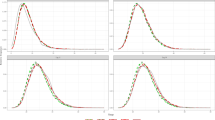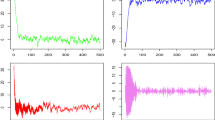Abstract
Goodness-of-fit tests are proposed for the innovation distribution in INAR models. The test statistics incorporate the joint probability generating function of the observations. Special emphasis is given to the INAR(1) model and particular instances of the procedures which involve innovations from the general family of Poisson stopped-sum distributions. A Monte Carlo power study of a bootstrap version of the test statistic is included as well as a real data example. Generalizations of the proposed methods are also discussed.


Similar content being viewed by others
References
Al-Osh MA, Alzaid AA (1987) First-order integer-valued autoregressive (INAR(1)) process. J Time Ser Anal 8:261–275
Alzaid AA, Al-Osh MA (1988) First-order integer-valued autoregressive (INAR(1)) process: distributional and regression properties. Stat Neerl 42:53–61
Babu GJ, Rao CR (1993) Bootstrap methodology. In: Rao CR (ed) Handbook of statistics, vol 9. Elsevier, Amsterdam, pp 627–659
Dobbie MJ, Welsh AH (2001) Models for zero-inflated count data using the Neyman type A distribution. Stat Model 1:65–80
Du JG, Li Y (1991) The integer-valued autoregressive (INAR\((p)\)) model. J Time Ser Anal 12:129–142
Epps TW (1995) A test of fit for lattice distributions. Commun Stat Theor Methods 24:1455–1479
Fokianos K, Rahbek A, Tjostheim D (2009) Poisson autoregression. J Am Stat Assoc 104:1430–1439
Genest C, Rémillard B (2008) Validity of the parametric bootstrap for goodness-of-fit testing in semiparametric models. Ann Inst H Poincare Probab Stat 44:1096–1127
Gürtler N, Henze N (2000) Recent and classical goodness-of-fit tests for the Poisson distribution. J Stat Plan Inference 90:207–225
Hand DJ, Daly F, Lunn AD, McConway KJ, Ostrowski E (1994) A handbook of small data sets. Chapman & Hall, London
Jazi MA, Jones G, Lai CD (2012a) First-order integer valued AR processes with zero inflated Poisson innovations. J Time Ser Anal 33:954–963
Jazi MA, Jones G, Lai CD (2012b) Integer valued AR(1) with geometric innovations. J Iran Stat Soc 11:173–190
Johnson NL, Kotz S, Kemp AW (1993) Univariate discrete distributions. Wiley, New York
Leucht A (2012) Characteristic function-based tests under weak dependence. J Multivar Anal 108:67–89
Leucht A, Neumann MH (2013) Degenerate \(U\)- and \(V\)-statistics under ergodicity: asymptotics, bootstrap and applications in statistics. Ann Inst Stat Math 65:349–386
Massé J, Theodorescu R (2005) Neyman type A distribution revisited. Stat Neerl 59:206–213
McKenzie E (1985) Some simple models for discrete variate time series. Water Resour Bull 21:645–650
McKenzie E (2003) Discrete variate time series. In: Shanbhag, Rao (eds) Handbook of statistics, vol 21. Elsevier, Amsterdam, pp 573–606
Meintanis SG (2008) New inference procedures for generalized Poisson distributions. J Appl Stat 35: 751–762
Meintanis SG, Nikitin YaYu (2008) A class of count models and a new consistent test for the Poisson distribution. J Stat Plan Inference 138:3722–3732
Meintanis SG, Swanepoel J (2007) Bootstrap goodness-of-fit tests with estimated parameters based on empirical transforms. Stat Probab Lett 77:1004–1013
Pavlopoulos H, Karlis D (2008) INAR(1) modeling of overdispersed count series with an enviromental application. Environmetrics 19:369–393
Rémillard B, Theodorescu R (2000) Inference based on the empirical probability generating function for mixtures of Poisson distributions. Stat Decis 18:349–366
Savani V, Zhigljavsky AA (2007) Efficient parameter estimation for independent and INAR(1) negative binomial samples. Metrika 65:207–225
Szűcs G (2008) Parametric bootstrap for continuous and discrete distributions. Metrika 67:63–81
Weiß CH (2008) Thinning operations for modeling time series of counts—a survey. Adv Stat Anal 92: 319–431
Acknowledgments
The support of research Grant Number 11699 (Department of Economics) from the Special Account for Research Grants of the National and Kapodistrian University of Athens is gratefully acknowledged. The authors would like to thank the reviewer for helpful comments that helped improving the material.
Author information
Authors and Affiliations
Corresponding author
Additional information
Simos G. Meintanis was on sabbatical leave from the University of Athens.
Appendix: Proofs
Appendix: Proofs
Proof of Equation (3.5)
From the definition below Eq. (3.4) we compute
Then the test statistic in Eq. (3.4) may be written as
where \(\mathcal{{I}}_j=\int _0^1 \int _0^1 S_j(u,v) u^av^adudv, \, j=1,\ldots ,6\).
We shall illustrate the computation of
Analogous are the computations of \(\mathcal{{I}}_j, \ j\ne 3\). To this end we have
and integration term-by-term leads to
where \(I_{t,s,a}:=I(Y_t+Y_s+a)\) and
So then by using the notation \(r_{t,s}\) introduced in Eq. (3.5) we have
which after some simple algebra is seen to coincide with the second term in Eq. (3.5). Similarly we obtain
As already noted, \(\mathcal{{I}}_3\) coincides with the second term in Eq. (3.5). Also it is easy to see that the sum \(\mathcal{{I}}_1+\mathcal{{I}}_2+\mathcal{{I}}_4\) gives the first term in Eq. (3.5), and \(\mathcal{{I}}_5+\mathcal{{I}}_6\) gives the third term in Eq. (3.5). Therefore by Eq. (7.1) the proof is complete.
Proof of Equation (4.2)
From Eq. (4.1) it follows that \(g_\varepsilon (U_{p^k})=e^{\lambda [\exp \{\varphi p^k(u-1)\}-1]}\), which when inserted in Eq. (2.2) yields
Proof of Equation (4.5)
From Eq. (4.4) it follows that
which when inserted in (2.2) yields,
Proof of Equations (4.10) and (4.11)
From Eq. (4.3) we have
Substituting these equations in the left-hand side of Eq. (4.10) yields
Clearly
Also
where \(S(u,v)=\sum \nolimits _{\ell =1}^\infty \frac{(\varphi (vU_p-1))^{\ell }}{\ell !} \frac{1}{1-p^{\ell +1}}\) and likewise
(Notice that \(S(u,v)<\infty \) by the ratio test for convergence of series). Then by substitution of Eqs. (7.4), (7.5) and (7.6) in Eq. (7.3), the proof is complete. The proof of Eq. (4.11) is completely analogous and it is therefore omitted.
Proof of Equation (4.12)
First replace the theoretical PGF and its derivatives by the corresponding empirical quantities in the definition below Eq. (4.10), and compute (use the notation \(U_p=1+p(u-1)\)),
Then the test statistic may be written as in Eq. (7.1). The corresponding integrals can be calculated analogously as in the proof of Eq. (3.5) above as
Collecting now the terms in Eq. (7.1) and comparing with the terms in Eq. (4.12), the proof is complete.
Proof of Equation (4.13)
In an analogous manner (see the proof of Eq. (4.12) above), from the definition below Eq. (4.11) compute
Then the test statistic may be written as in Eq. (7.1). Now clearly \(\mathcal{{I}}_1, \mathcal{{I}}_4\) and \(\mathcal{{I}}_5\) coincide with the corresponding integrals in the proof of Eq. (4.12) above. Also, by straightforward algebra
and the proof is complete by a further appeal to Eq. (7.1) and by comparison with Eq. (4.13).
Proof of Equation (4.14)
From Eq. (2.3) we have
Substituting these equations in the left-hand side of Eq. (4.14) yields
Clearly the PGF of the NB distribution in Eq. (4.7) satisfies
Also from Eq. (4.8) write
and compute
where \(S(u,v)=\sum _{k=0}^\infty (\varrho (1-vU_p)+p^{-k})^{-1}\). (Notice that \(S(u,v)<\infty \), since \(\varrho (1-vU_p)>0\) and therefore \(S(u,v)<\sum _{k=0}^\infty p^{k}<\infty ,\,0<p<1\)). Likewise we can show that
and by substitution of Eqs. (7.8), (7.9) and (7.10) in Eq. (7.7), the proof is complete.
Rights and permissions
About this article
Cite this article
Meintanis, S.G., Karlis, D. Validation tests for the innovation distribution in INAR time series models. Comput Stat 29, 1221–1241 (2014). https://doi.org/10.1007/s00180-014-0488-z
Received:
Accepted:
Published:
Issue Date:
DOI: https://doi.org/10.1007/s00180-014-0488-z




